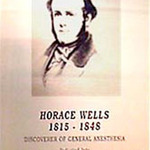Dr. Horace Wells
Hartford, Connecticut — 1815-1848
Dr. Wells was born on January 21, 1815, Hartford, Vermont. He attended select schools for 12 years. He studied dentistry between 1834 and 1836 in Boston, Massachusetts, and eventually went to Hartford, Connecticut to practice dentistry. At that time he was considered a leader of his profession.
In 1840, a discussion with Linus P. Brochett, Hartford, CT, showed that Wells was deeply impressed with the idea that some discovery would yet be made by which dental and other operations might be performed without pain. In 1814, Dr. William T.G. Morton of Farmington, CT, studied dentistry under Dr. Wells. Later, Dr. Morton would go on to demonstrate ether in Boston in 1846. History will show that both of these men eventually fought over the discovery of general anesthesia. There was always a strange relationship between them.
Dr. Wells attended a very important lecture on December 10, 1844 by Garner Colton on chemical phenomenon where the idea of an inhalation anesthesia crystallized in Well’s mind. On December 11th 1844, Dr. Wells inhaled nitrous oxide gas administered by Colton, and had an aching 3rd molar painlessly extracted by his friend and former pupil, Dr. John Riggs , later of Riggs’ Disease fame. This was the first operation performed under nitrous oxide inhalation anesthesia.
Dr. Wells then began to experiment with the administration of nitrous oxide to his patients to prevent pain while teeth were being extracted. Dr. Wells went to Europe and carried on his work in general anesthesia throughout many capitals of Europe. Upon his return, he laid claim to be the true discoverer of general anesthesia, nitrous oxide. His discovery was given official recognition on December 9th , 1844. Dr. Wells published a claim as the discoverer of general anesthesia, nitrous oxide, in the Daily Hartford Courant.
On January 31st, 1845, Wells lectured before Dr. John C. Warren’s class on “The Use of Nitrous Oxide for the Prevention of Pain”, and demonstrated anesthesia for extractions before Harvard Medical students in Boston. Dr. William T.G. Morton was present.
Following these activities, Dr. Wells became strangely ill and unable to practice dentistry . Dr. Wells from that time forward led a very controversial and tortured life. He fought with Morton over the rightful discovery of general anesthesia, and especially nitrous oxide. Dr. Wells became mentally deranged and committed suicide in prison on January 26th, 1848. The Daily Hartford Courant had the following editorial:
“The Late Horace Wells. The death of this gentleman has caused profound and melancholy sensation in the community. He was an upright and estimable man, and had the esteem of all who knew him, of undoubted piety, and simplicity and generosity of character.”
A death mask of Horace Wells hangs in the Boston Medical Library. It was acquired some time before 1892, but no one knows how the library acquired the mask or by whom. Dr. Wells was the recipient of many honors, both in this country and abroad. There are memorials, busts and statues to Horace Wells all over the world, and a Memorial Window in Center Church Hartford, Ct. The Connecticut State Dental Association recently celebrated the 150th Anniversary of the discovery of general anesthesia with a testimonial and memorial dinner in his honor. The world is so much better off because Horace Wells, the dentist, gave us general anesthesia for the control of pain during surgery.
In spite of the tortured life of Horace Wells, he left a legacy for all time. The Academy is privileged and honored to induct Horace Wells into the PFA International Hall of Fame of Dentistry.



